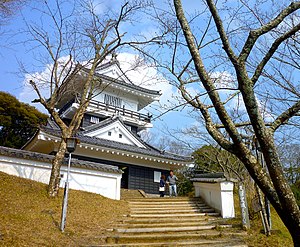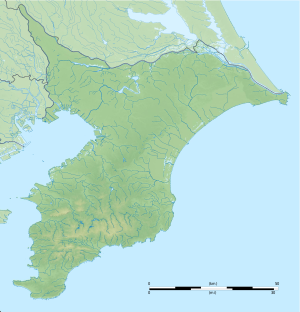Kururi Castle
| Kururi Castle | ||
|---|---|---|
|
Kururi Castle, castle tower |
||
| Creation time : | 1456 | |
| Castle type : | Yamajiro (mountain castle) | |
| Place: | Kimitsu | |
| Geographical location | 35 ° 17 '15.3 " N , 140 ° 5' 24.1" E | |
|
|
||
The castle Kururi ( Japanese 久留里城 , Kururi-jō ) is located in the city of Kimitsu in Chiba Prefecture . In the Edo period , the Kuroda last resided there as a smaller Fudai daimyo .
Lords of the castle in the Edo period
- From 1601 the Tsuchiya with an income of 20,000 Koku ,
- from 1742 the Kuroda with 30,000 Koku.
history
In 1456, Takeda Nobunaga ( 武田 信 長 ) built the first Kururi Castle. Later Satomi Yoshitaka ( 里 見 義 堯 ; 1512–1574) built a castle on the ridge east and south of it in 1537, which he called New Kururi ( 新 久留 里 城 , Shin-Kururi-jō ) and used it as a residence. To the southwest, the Obitsugawa River formed a natural line of defense. But in 1578 the then lord of the castle, Satomi Yoshiyori ( 里 見 義 頼 ; 1555–1586) left the castle and moved to the province of Awa , where he occupied it with a representative.
After Tokugawa Ieyasu had taken over the Kantō provinces in 1590, the Ōsuka ( 大 須 賀 ) and then the Tsuchiya became lords of the castle. After the Tsuchiya were moved in 1679, the castle was not used for a long time and fell into disrepair. Then the Kuroda received the place in 1742 and restored the castle. They then remained lords of the castle until the Meiji Restoration in 1868.
The attachment
The castle lay on a forked ridge that stretched from southwest to northeast. The innermost castle area, the Hommaru ( 本 丸 ), was laid out at the highest point, with the second castle area, Ni-ni-maru ( 二 の 丸 ) in front of it to the southwest . The Hommaru was protected by the Hadano pre-area ( 波 多 野 曲 輪 , Hadano-kuruwa ) and the Tenshin-pre-area ( 天 神曲 輪 , Tenshin-kuruwa ). The Ni-no-maru was flanked by the Yakushi pre-area ( 薬 師 曲 輪 , Yakshi-kuruwa ). There was also the Amida pre-area ( 阿 弥陀 曲 輪 , Amida-kuruwa ). The third Brug area, the San-no-maru ( 三 の 丸 ), extended at the foot of the hill .
After 1868 the castle was largely demolished and the central castle area is now a public park. However, the remains of the castle complex including the outer castles have been preserved. In 1979 a castle tower ( 天 守 , tenshu ) was built in Hommaru and a building in Ni-no-maru that houses information about the castle. The San-no-maru has become partly residential and partly field.
Remarks
- ↑ According to Papinot, these Kuroda were not a branch of the great Kuroda , but a family that was derived from Emperor Senka and received daimyo rank in 1700. The family resided in Shimodate ( Hitachi Province ) from 1703 , in Numata ( Kōzuke Province ) from 1732 and then at Kururi Castle.
literature
- Sugai, Yasuo: Kururi-jo in: Miura, Masayuki (Ed.): Shiro to jinya. Tokoku-hen. Gakken, 2006. ISBN 978-4-05-604378-5 , p. 100.
- Edmond Papinot: Historical and Geographical Dictionary of Japan. Reprint of the 1910 edition. Tuttle, 1972, ISBN 0-8048-0996-8 . <<

